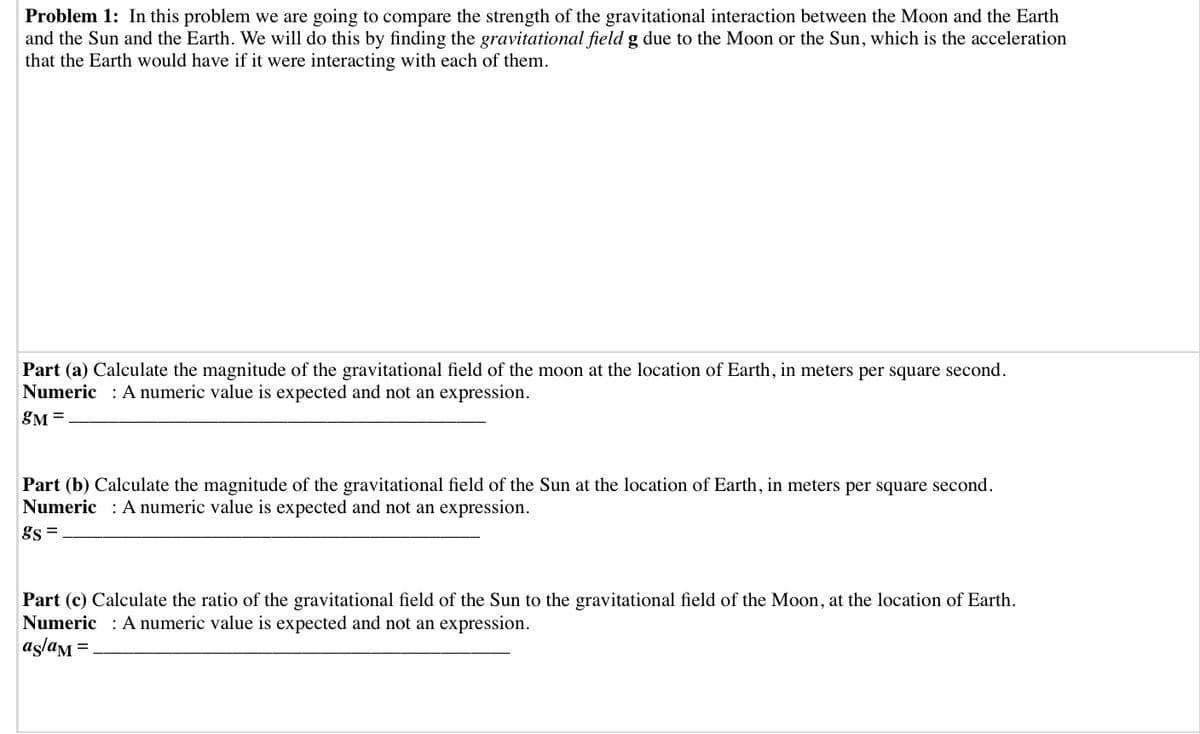Problem 1: In this problem we are going to compare the strength of the gravitational interaction between the Moon and the Earth and the Sun and the Earth. We will do this by finding the gravitational field g due to the Moon or the Sun, which is the acceleration that the Earth would have if it were interacting with each of them. Part (a) Calculate the magnitude of the gravitational field of the moon at the location of Earth, in meters per square second. Numeric : A numeric value is expected and not an expression. SM =. Part (b) Calculate the magnitude of the gravitational field of the Sun at the location of Earth, in meters per square second. Numeric : A numeric value is expected and not an expression. gs = Part (c) Calculate the ratio of the gravitational field of the Sun to the gravitational field of the Moon, at the location of Earth. Numeric : A numeric value is expected and not an expression. aşlam =.
Problem 1: In this problem we are going to compare the strength of the gravitational interaction between the Moon and the Earth and the Sun and the Earth. We will do this by finding the gravitational field g due to the Moon or the Sun, which is the acceleration that the Earth would have if it were interacting with each of them. Part (a) Calculate the magnitude of the gravitational field of the moon at the location of Earth, in meters per square second. Numeric : A numeric value is expected and not an expression. SM =. Part (b) Calculate the magnitude of the gravitational field of the Sun at the location of Earth, in meters per square second. Numeric : A numeric value is expected and not an expression. gs = Part (c) Calculate the ratio of the gravitational field of the Sun to the gravitational field of the Moon, at the location of Earth. Numeric : A numeric value is expected and not an expression. aşlam =.
Physics for Scientists and Engineers: Foundations and Connections
1st Edition
ISBN:9781133939146
Author:Katz, Debora M.
Publisher:Katz, Debora M.
Chapter7: Gravity
Section: Chapter Questions
Problem 37PQ: The Sun has a mass of approximately 1.99 1030 kg. a. Given that the Earth is on average about 1.50 ...
Related questions
Question
Please answer question 1

Transcribed Image Text:Problem 1: In this problem we are going to compare the strength of the gravitational interaction between the Moon and the Earth
and the Sun and the Earth. We will do this by finding the gravitational field g due to the Moon or the Sun, which is the acceleration
that the Earth would have if it were interacting with each of them.
Part (a) Calculate the magnitude of the gravitational field of the moon at the location of Earth, in meters per square second.
Numeric : A numeric value is expected and not an expression.
gM =
Part (b) Calculate the magnitude of the gravitational field of the Sun at the location of Earth, in meters per square second.
Numeric : A numeric value is expected and not an expression.
gs =
Part (c) Calculate the ratio of the gravitational field of the Sun to the gravitational field of the Moon, at the location of Earth.
Numeric : A numeric value is expected and not an expression.
aşlam =.
Expert Solution
This question has been solved!
Explore an expertly crafted, step-by-step solution for a thorough understanding of key concepts.
This is a popular solution!
Trending now
This is a popular solution!
Step by step
Solved in 2 steps

Knowledge Booster
Learn more about
Need a deep-dive on the concept behind this application? Look no further. Learn more about this topic, physics and related others by exploring similar questions and additional content below.Recommended textbooks for you

Physics for Scientists and Engineers: Foundations…
Physics
ISBN:
9781133939146
Author:
Katz, Debora M.
Publisher:
Cengage Learning

Principles of Physics: A Calculus-Based Text
Physics
ISBN:
9781133104261
Author:
Raymond A. Serway, John W. Jewett
Publisher:
Cengage Learning

Classical Dynamics of Particles and Systems
Physics
ISBN:
9780534408961
Author:
Stephen T. Thornton, Jerry B. Marion
Publisher:
Cengage Learning

Physics for Scientists and Engineers: Foundations…
Physics
ISBN:
9781133939146
Author:
Katz, Debora M.
Publisher:
Cengage Learning

Principles of Physics: A Calculus-Based Text
Physics
ISBN:
9781133104261
Author:
Raymond A. Serway, John W. Jewett
Publisher:
Cengage Learning

Classical Dynamics of Particles and Systems
Physics
ISBN:
9780534408961
Author:
Stephen T. Thornton, Jerry B. Marion
Publisher:
Cengage Learning

College Physics
Physics
ISBN:
9781305952300
Author:
Raymond A. Serway, Chris Vuille
Publisher:
Cengage Learning

Stars and Galaxies
Physics
ISBN:
9781305120785
Author:
Michael A. Seeds, Dana Backman
Publisher:
Cengage Learning
